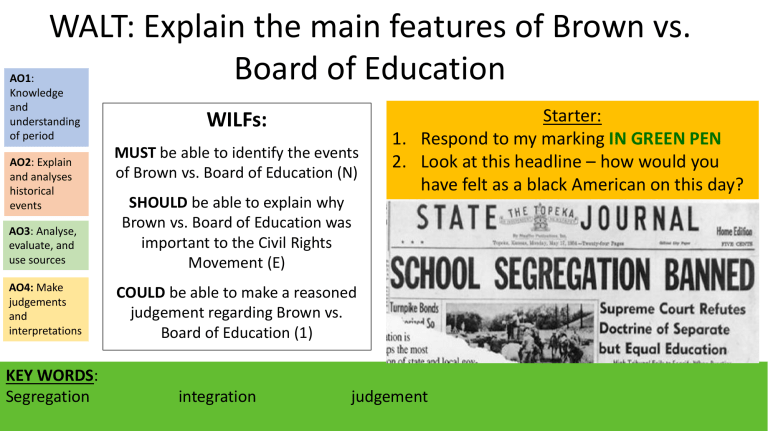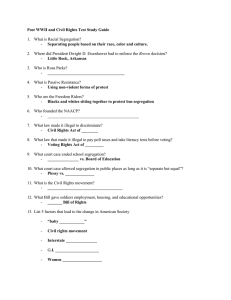
WALT: Explain the main features of Brown vs. Board of Education AO1: Knowledge and understanding of period AO2: Explain and analyses historical events WILFs: MUST be able to identify the events of Brown vs. Board of Education (N) AO3: Analyse, evaluate, and use sources SHOULD be able to explain why Brown vs. Board of Education was important to the Civil Rights Movement (E) AO4: Make judgements and interpretations COULD be able to make a reasoned judgement regarding Brown vs. Board of Education (1) KEY WORDS: Segregation integration Starter: 1. Respond to my marking IN GREEN PEN 2. Look at this headline – how would you have felt as a black American on this day? judgement Spelling test 1. Civil Rights Movement 2. Freedom 3. Jim Crow Laws 4. Segregation 5. Racism MUST be able to identify the events of Brown vs. Board of Education (N) Topeka, Kansas Tasks: 1. We are going to read a passage about Brown vs. Board of Education together. 2. You will create a storyboard with the story of Brown vs. Board of Education. MUST be able to identify the events of Brown vs. Board of Education (N) Linda Brown was a young African American girl who lived in Topeka, Kansas. She was born in 1943, and her family wanted the best education for her. There was a good school, Sumner Elementary only 7 blocks from her home. The school was for white children, and due to the segregation in American schools, Linda was not allowed to attend. Linda was forced to attend Monroe Elementary School for African American children. Monroe Elementary School had broken ceiling tiles, cracks in the floors and walls, broken windows and no central heating. She had to walk 2 miles to school every single day. Her father, Oliver Brown, was helped by the National Association for the Advancement of Coloured people (NAACP) to bring a legal case against the education board. This court case was called Brown versus Board of Education. On 19 May 1954 the court declared that segregation was against the law and the constitution of the USA. The Board of Education of Topeka and every other education board were forced to bring segregation to an end. In theory, this should have ended segregation in schools. However many schools ignored this, and by 1956, in six southern states, not a single black child was attending any school where there were white children. MUST be able to identify the events of Brown vs. Board of Education (N) Linda Brown was a young African American girl who lived in Topeka, Kansas. She was born in 1943, and her family wanted the best education for her. There was a good school, Sumner Elementary only 7 blocks from her home. The school was for white children, and due to the segregation in American schools, Linda was not allowed to attend. Linda was forced to attend Monroe Elementary School for African American children. Monroe Elementary School had broken ceiling tiles, cracks in the floors and walls, broken windows and no central heating. She had to walk 2 miles to school every single day. Her father, Oliver Brown, was helped by the National Association for the Advancement of Coloured people (NAACP) to bring a legal case against the education board. This court case was called Brown versus Board of Education. On 19 May 1954 the court declared that segregation was against the law and the constitution of the USA. The Board of Education of Topeka and every other education board were forced to bring segregation to an end. In theory, this should have ended segregation in schools. However many schools ignored this, and by 1956, in six southern states, not a single black child was attending any school where there were white children. Linda Brown had to walk _________ to school because _____ __________________ __________________ The conditions of the school were poor, for example __________ __________________ __________________ This showed that the education system in America was not equal because _____ _________________ As a result of this, her father ____________ __________________ __________________ The Supreme Court decided that __________________ __________________ However, by 1956 __________________ __________________ __________________ SHOULD be able to explain why Brown vs. Board of Education was important to the Civil Rights Movement (E) Do you think Brown vs. the Board of Education was a total victory? Total victory 1. Draw a short arrow in your book and put a cross where your opinion is. 2. Justify your opinion Sentence starters: I think Brown vs. the Board of Education was a ____________ victory. This is because… Partial victory Key words: segregation integration equality education Brown vs. Board of Education https://www.youtube.com/watch?v=1siiQelPHbQ SHOULD be able to explain why Brown vs. Board of Education was important to the Civil Rights Movement (E) Add more detail use the facts below: Sentence starters: I know there was a victory because.. I know the victory was limited because… Most southern Education was states did not seen as the integrate most important area of integration ¼ million people joined White Citizen Councils to defend segregation The Federal Government agreed with integration Membership of the racist organisation the KKK increased No date was set for when schools had to be integrated COULD be able to make a reasoned judgement regarding Brown vs. Board of Education (1) Different interpretations Do you think the ruling Brown v. Board of Education (1954) did more harm than good? Give 5 reasons why the case arguably failed. One question I still have Two things I have enjoyed or found useful Three facts I have learnt with your green pen
